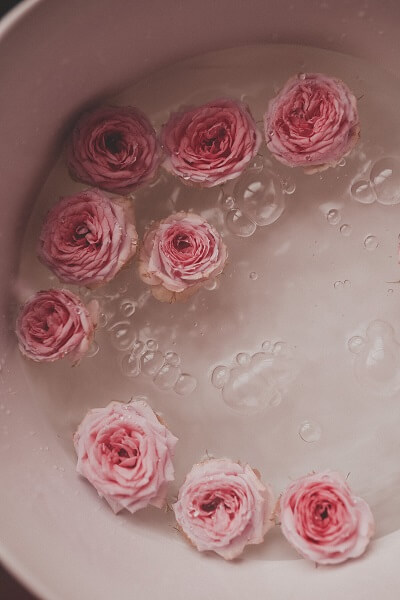The Victorians and Makeup Part 1: The Virtue of Skincare - Emily Owen
The Victorians and Makeup Part 1: The Virtue of Skincare

Let’s start with a little story. I recently purchased a miracle blemish remover (if the reviews are to be believed) containing the magic ingredient salicylic acid…
Now, I’m someone who doesn’t use cosmetics often and I made two mistakes: 1) I didn’t think to do a patch test 2) I didn’t understand you’re supposed to put a few drops of this stuff into your palm and massage it onto your face – I smeared it directly all over my cheeks. Five minutes later my cheeks started to tingle. When I glanced in the mirror, it looked as if they’d been sunburnt. Some camomile lotion took care of the redness, which faded to an actually quite pleasant rosy hue, before vanishing a couple of hours later. But this little beauty blunder got me thinking about what cosmetics Victorian ladies had available to them. In this article, I’ll be exploring nineteenth-century beauty regimes.
Victorian attitudes to makeup
One thing to bear in mind is that the Victorian public had a different attitude to makeup compared to what we do today, when you see cosmetic adverts on telly, in magazines, or popping up on social media. Makeup was seen as a form of artifice. Ladies were not expected to wear coloured makeup under any circumstances; only actresses and prostitutes painted their faces. That’s not to say that all ‘respectable’ women resisted the temptation to rectify imperfections and enhance their features with the aid of cosmetics. These ladies applied their makeup secretly. A middle-class wife would have to keep her creams and lotions hidden from her husband, if she wanted him to think that she always looked so fresh and lovely.
The makeup Victorian ladies used was also a lot more discreet than the array of makeup available today – and certainly more subtle compared to that used by their extravagant Georgian forebearers. Lord Leyton’s more bold experimentation with makeup in my stories seems even more radical when one considers the context of the time (depending how you look at it he’s ever behind the times or ahead of the curve – ‘fashion repeats itself tediously’ as he aptly remarks). Then again, he is an eccentric nobleman. Our middle-class lady might add a spot of red to her cheeks and lips, but that’s about it.
Skincare and virtue
Nowadays a golden tan is coveted, but back then pale skin was fashionable. Like us, however, the Victorians wanted flawlessly smooth, soft skin free of blemishes. It was believed at the time that a lady’s complexion was affected by her physical health and state of mind. As long as she did not overexert herself – physically or mentally – whilst maintaining virtuous, gentle thoughts and a cheerful demeanour, then her inner beauty would shine through and she’d have lovely skin. If she was a debauched, dissolute drunkard, then it would show in her blemished skin. While a dermatologist today would dismiss this as nonsense, perhaps so too did the Victorian ladies themselves. Rather than relying on virtuous thoughts and constant smiles, they employed other means to get the clear complexion they craved.

Cleansers
Cleanliness was important to the Victorians, so cleansing the skin was socially acceptable – there being a perceived association between bodily and moral cleanliness. Washing the face with soap and water, using a sponge or very soft brush, was one way Victorian women cleansed their skin. Wash powders and cosmetic washes were also widely used, although medical journals and lady’s magazines of the time claimed that they blocked the pores and were an ineffective means of exfoliation.
As you couldn’t really buy cosmetics over the shop counter until the twentieth century, ladies made their own cosmetics at home (or asked their maids to), using recipes from health and beauty books or lady’s magazines of the time. Elderflower water was used for washing the hands and face, whilst camomile water was also a popular skin cleanser. Elderflower water is still used in skincare today: regarded for its ability to soften skin, as well as for its properties as a skin lightener and anti-wrinkle herb. Camomile’s anti-inflammatory properties have also ensured its continued use in skincare, with camomile-based face toners helping to reduce redness and irritation. Rose water was a popular cleanser at the start of the Victorian era which, whilst having a lovely fragrance, wasn’t really effective at removing dirt and oil. At least rose water was harmless; some cleanser recipes of the period called for arsenic, mercury and lime!
Cold cream
Cold cream was the must-have moisturiser of the time. After washing her face, a Victorian lady might apply this pure white cream to her face, hands, neck, and arms – basically any part of her body on display that she wanted to be soft and moisturised. But cold cream wasn’t a particular make of moisturiser or even made using a specific recipe. There were many recipes for cold cream – some of which listed hog’s lard and mercury amongst their ingredients. The cream could be sumptuously scented with ingredients such as: rose or orange flower water, oil of bergamot, almond oil, lavender, or vanilla and ambergris.
By the latter quarter of the nineteenth century, more adverts for moisturisers and other cosmetics began to appear in print, although painting your face with coloured cosmetics was still socially unacceptable into the first half of the twentieth century. In the next article, we’ll look at Victorian makeup in greater detail, including face powder and rogue.